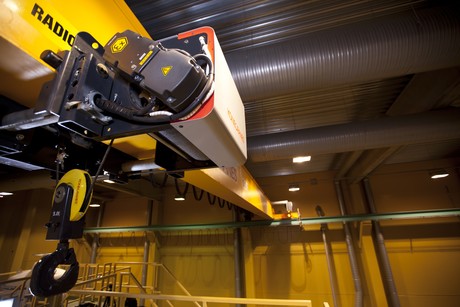5 reasons to specify an ATEX and IECEx approved crane in hazardous environments

Cranes and hoists often operate in hazardous, dangerous and potentially explosive areas, where a single incident can cause significant personal injury, damage, downtime and loss of income or production. Industries commonly affected include bulk handling and distribution, transport, chemical processing, energy, food and beverage, manufacturing, logistics, mining and mineral processing, oil and gas, materials handling, mechanical, production and process engineering, industrial logistics, water, wastewater and biomass recycling.
It is therefore important to take steps to ensure crane safety, particularly in environments where there are flammable substances, chemicals, vapours, gases from liquids, volatile substances and dust.
According to Konecranes Industrial Crane Sales Manager David Wilson, there are five main reasons why companies should always specify an ATEX and IECEx approved crane in hazardous environments:
- Safety. Without the proper cooling systems in place, a crane’s engine may reach very high temperatures and cause minor sparks that are harmless in other situations, but deadly in explosive environments, where vapours, mist, dust and other contaminants can react with a single spark with devastating consequences. In dusty environments, it is also essential to have motors and engines completely covered, to avoid flammable dust particles coming into contact with a heated area. Non-ATEX and IECEx approved lifting equipment may have these safety features, but ATEX and IECEx approved equipment confirms it.
- Compliance. ATEX and IECEx are constantly being expanded and improved, so companies need to learn the latest requirements and to incorporate them into their duty of care. The ATEX directive also gives strict rules for constant production and product quality follow-up. Konecranes has multiple certifications to substantiate the quality of its products: IECEx for the world, ATEX for Europe, CSA US for the United States and INMETRO for Brazil.
- It makes good business sense to do so. The small initial saving made from buying a non-ATEX and IECEx certified crane will be dwarfed by the costs and downtime if an explosion or incident occurs, where the crane or other machinery may need to be replaced, as well as factoring in loss of inventory and significant downtime. In addition, a worker may have been injured in the incident.
- It avoids additional risk. There may be liability issues for crane operators and owners if they were aware they were working in a potentially high explosive environment and did not select a crane with ATEX and IECEx certification. If a person is injured and finds out that an ATEX and IECEx certified crane was needed for that environment, there may be legal consequences for the owner/operator.
- Get the most out of the crane. In order to maintain compliance with ATEX and IECEx regulations, the cranes have to be regularly inspected, serviced and quality control checked, which means there is a high level of traceability and a lower chance of problems occurring that would reduce design life.
Konecranes has extensive experience in explosion-proof and ATEX and IECEx compliant cranes. The company manufactures its EX ranges to the globally respected ATEX and IECEx compliance standards aimed at improving the health and safety protection of workers potentially at risk from explosive atmospheres. Konecranes also performs crane reliability studies, inspections, service and maintenance on all makes and models of crane.
Level crossing AI safety solution has merit
Among the merit recipients in the 2025 VIC iAwards was an edge AI solution designed to enhance...
Laser bird deterrent boosts tram depot safety
A Melbourne tram depot has reduced bird roosting by 90%, boosting safety through a fully...
Traffic management training review proves a winning formula
A review of traffic management training and a practical, people-focused approach was behind a...







